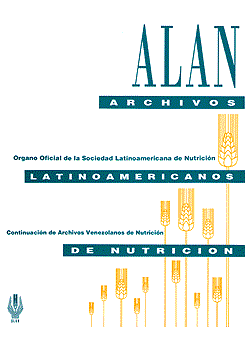Use of a predictive model for food insecurity estimates in Brazil
Palavras-chave:
Predictive Statistical Model, Severe Food Insecurity, Municipalities, Modelo Estadístico Predictivo, Inseguridad Alimentar Grave, MunicipalidadesResumo
In 2004 the National Household Survey (Pesquisa Nacional por Amostras de Domicílios - PNAD) estimated the prevalence of food and nutrition insecurity in Brazil. However, PNAD data cannot be disaggregated at the municipal level. The objective of this study was to build a statistical model to predict severe food insecurity for Brazilian municipalities based on the PNAD dataset. Exclusion criteria were: incomplete food security data (19.30%); informants younger than 18 years old (0.07%); collective households (0.05%); households headed by indigenous persons (0.19%). The modeling was carried out in three stages, beginning with the selection of variables related to food insecurity using univariate logistic regression. The variables chosen to construct the municipal estimates were selected from those included in PNAD as well as the 2000 Census. Multivariate logistic regression was then initiated, removing the non-significant variables with odds ratios adjusted by multiple logistic regression. The Wald Test was applied to check the significance of the coefficients in the logistic equation. The final model included the variables: per capita income; years of schooling; race and gender of the household head; urban or rural residence; access to public water supply; presence of children; total number of household inhabitants and state of residence. The adequacy of the model was tested using the Hosmer-Lemeshow test (p=0.561) and ROC curve (area=0.823). Tests indicated that the model has strong predictive power and can be used to determine household food insecurity in Brazilian municipalities, suggesting that similar predictive models may be useful tools in other Latin American countries.
La Investigación Nacional por Muestreo de Domicilios de 2004 (PNAD), generó estimativas de la prevalencia de inseguridad alimentaria y nutricional en Brasil. Todavía las informaciones de PNAD no pueden ser desagregadas para las municipalidades. El objetivo de este estudio fue construir un modelo estadístico predictivo para inseguridad alimentaria grave en las municipalidades empleando la base de datos PNAD. Los criterios de exclusión fueran: hogares con datos incompletos (19.30%), informantes menores de 18 anos (0.07%), hogares colectivos (0.05%) y hogar con jefe indígena (0.19%). El modelaje fue realizado en 3 etapas, la primera fue la selección de las variables relacionadas con inseguridad alimentar grave mediante regresión logística única. Fueron escogidas variables presentes en PNAD y en el Censo Demográfico de 2000. Por último se realizó regresión logística múltiple, siendo retiradas las variables no significativas según el Odds Ratio ajustado. Fue usado el test de Wald para evaluar la significancia estadística de los coeficientes en la ecuación logística. El modelo final incluye las variables: renta domiciliar per cápita, años de escolaridad, raza y sexo del jefe de familia, localización urbana o rural del domicilio, disponibilidad de red de agua potable, presencia de niños, total de miembros en la familia y provincia de residencia. Se verificó la adecuación del modelo usando el test de Hosmer-Lemeshow (p=0,56) y la Curva de ROC (área=0,823). Los testes indican que el modelo tiene gran poder predictivo para estimar la inseguridad alimentaria grave en municipalidades brasileñas, sugiriendo que modelos predictivos similares puedan ser herramientas útiles en otros países Latinoamericanos.
Downloads
Downloads
Como Citar
Edição
Secção
Licença
Usted es libre de:
Compartir — copiar y redistribuir el material en cualquier medio o formato
Adaptar — remezclar, transformar y construir a partir del material
La licenciante no puede revocar estas libertades en tanto usted siga los términos de la licencia
Bajo los siguientes términos:
Atribución — Usted debe dar crédito de manera adecuada, brindar un enlace a la licencia, e indicar si se han realizado cambios. Puede hacerlo en cualquier forma razonable, pero no de forma tal que sugiera que usted o su uso tienen el apoyo de la licenciante.
NoComercial — Usted no puede hacer uso del material con propósitos comerciales.
No hay restricciones adicionales — No puede aplicar términos legales ni medidas tecnológicas que restrinjan legalmente a otras a hacer cualquier uso permitido por la licencia.


